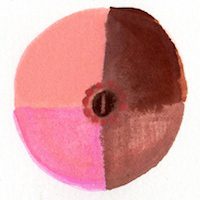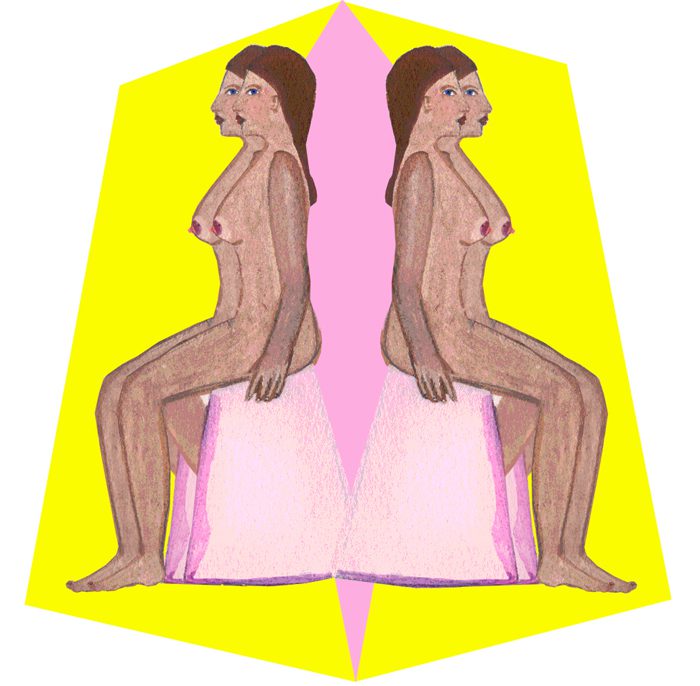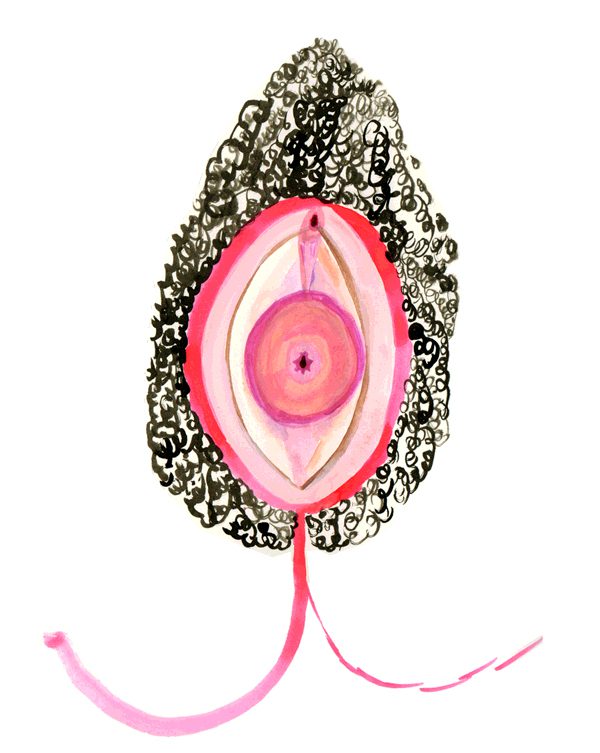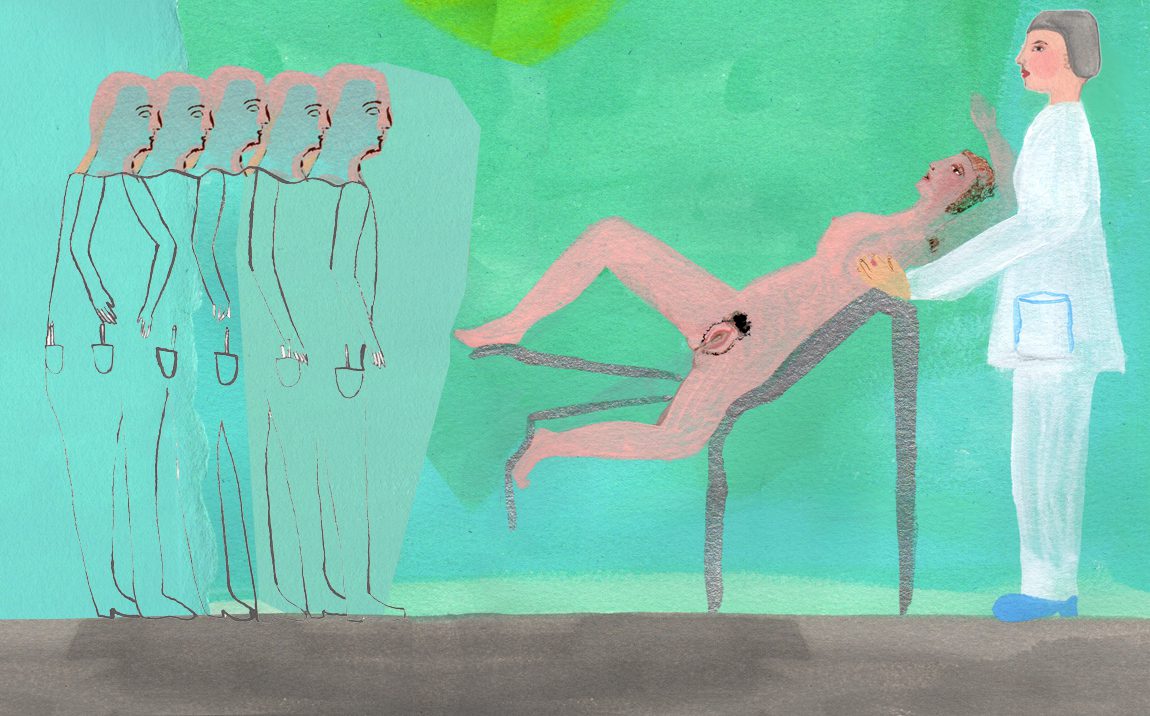
It’s a Monday night, and five young medical students huddle in the far corner of an exam room while I pull on latex gloves. “Come closer,” I say, and I step next to Julie, the woman lying on her back on the exam table. The students shuffle toward us, like a single entity with multiple arms and legs and peering eyes. For some of them, this will be the first time they’ve ever seen, in person, a live woman’s naked body. For all of them, it will be the first time they perform a breast exam or palpate a uterus or slide a speculum into a vagina in an attempt to see the shining ring of a cervix tucked inside.
“I’m going to do a breast exam now, Julie,” I say. I am turned toward her, looking at her eyes, but I raise my voice so all the students can hear me. “Can you raise your right arm above your head?” She says sure and raises her arm, resting it on the exam table. “We need to slide your gown over your arm so I can examine your breast—do you want help?” She says no thanks and does it herself, and I turn to the students. “Each time you touch a patient, you need to let her know beforehand. No surprises. It’s her body, and she’s granting you the privilege to be in her physical space.”
I turn back to Julie. “I’m going to touch you now, is that okay?” When she says yes, I place my hands on either side of her right breast and begin pressing my fingers in tiny circles, moving clockwise around her breast. I explain how she can do this part at home for herself, once a month, and describe the quadrants of her breast as I make my way closer to the areola. I describe the size and texture of the nodules I am checking for—what cancer would feel like. “Hard, like an eraser nub,” I say. After checking her nipple for fluid and then spending extra time in the upper outer quadrant of her breast, I check her armpit, and then I ask if I can examine the other breast. She says yes, and I reach across her body. The students have gathered around the table and are now leaning in to watch me repeat each motion on her left breast. I ask Julie to sit up and drop her gown from her shoulders so I can look at her breasts while she’s seated upright, and the students move to give us space. “I’m looking for any unevenness in skin texture, any differences from right to left,” I say, and I ask her to lean forward. I watch how her breasts swing. “I’m looking for dimpling, any catching as the tissue moves.”
 I’ve said these lines to Julie dozens of times. She knows what’s coming next—the stirrups, the internal exam, and the real excitement, the speculum. She and I and a team of women meet on Monday nights in the basement of a cancer treatment center with dozens of medical students to teach them how to give gynecological exams. Our task, the role of the “patient” at least, has at times been performed by prostitutes and by anesthetized housewives. Even mannequins have been used as “patients.” We’re called Gynecological Teaching Assistants. None of us are doctors or nurses, but we’ve all been trained in how to give a thorough gynecological exam. Our director is an attending physician, and she bounces from room to room, unable to spend much time with any one group of students. It’s Julie and I and the other GTAs who do the real work of teaching these kids how to treat a woman on the exam table. We are alive, awake, and very aware that they will learn from us tonight the privilege and responsibility of providing good medical care to women.
I’ve said these lines to Julie dozens of times. She knows what’s coming next—the stirrups, the internal exam, and the real excitement, the speculum. She and I and a team of women meet on Monday nights in the basement of a cancer treatment center with dozens of medical students to teach them how to give gynecological exams. Our task, the role of the “patient” at least, has at times been performed by prostitutes and by anesthetized housewives. Even mannequins have been used as “patients.” We’re called Gynecological Teaching Assistants. None of us are doctors or nurses, but we’ve all been trained in how to give a thorough gynecological exam. Our director is an attending physician, and she bounces from room to room, unable to spend much time with any one group of students. It’s Julie and I and the other GTAs who do the real work of teaching these kids how to treat a woman on the exam table. We are alive, awake, and very aware that they will learn from us tonight the privilege and responsibility of providing good medical care to women.
After I’ve completed Julie’s breast and pelvic exam, supervised two medical students examining her, and then been examined three times myself, I clean up and dress for home. I will ride my bike the two miles to home, sore from the multiple internal exams and speculum insertions. My car, an old Toyota with more than 200,000 miles on the odometer, sits at home for use only when I absolutely need it. I cobble together money from tips I make as a waitress during the day, and then, once a week, I work for three hours at $30.00 an hour as a GTA. I add this to the child support my ex pays every month and try to make wise choices about buying food and paying the electric bill and the mortgage.
It was a shock when my husband left. I’d been a stay-at-home mom for five years, taking care of our two young boys and only working odd jobs if they were compatible with staying at home with the kids. Being alone and poor is a struggle, a different kind of struggle than being married and poor. Ours was a difficult marriage, full of threats and various kinds of abuse, but it was what I’d thought was the only option when I left home with him at sixteen. When I realized I was pregnant a few years later, I didn’t want an abortion—I wanted to be a mom, a good one. Though we were poor college students at the time, my husband and I agreed we didn’t want our child in daycare, so I stayed home with the baby and later his little brother, thinking all the while I was doing my part, my best, to be a good mother and a good enough wife.
Poverty and single motherhood have given me an odd kind of liberation. If I hadn’t been so poor after the divorce, I’d never have considered being a gynecological teaching assistant. If I’d still been married to my ex, though, I’d never have considered doing this work. He threatened me throughout our marriage—if I ever had sex with someone else, he’d kill me. No questions asked. He suspected me of flirting with men, always questioning my intentions, so the only significant contact I had with men for more than ten years was with him and, occasionally, my brothers. Now, once a week, I was lying in a hospital gown on an exam table in front of a group of young students, some male, some female, and I was teaching them how to respect a woman’s body. It wasn’t sex, but in my ex’s eyes, it would have been.
Some Mondays, Julie takes the first turn as the “patient,” and I am the “doctor.” Other times, we switch. If one of us is bleeding with menstrual flow, the other sometimes agrees to a few extra exams to lighten her burden. More often, though, we just keep it even, no matter if there is blood or bloating or discomfort. These medical students might have to examine a rape victim someday, or a woman presenting with STD symptoms while she’s on her period. It’s important, to Julie and me and the other GTAs, that the students learn to approach the female body with respect and compassion at the peak of health as well as at the depths of illness or suffering, which is when a woman would be at her most vulnerable and would need all of the empathy these young doctors-to-be could give.
Going first as the “doctor” is easier. Because I’m performing a role the students associate with authority—a position they are hoping to someday step into themselves—the medical students look to me with respect. They see me as the teacher, and they understand that I’m evaluating them. What is more difficult is to be the “patient” first. I’m on my back, the first to be exposed and poked and prodded in front of a room full of young, gangly onlookers. If I am the patient first, it helps that I know and trust Julie. If she is the doctor, she establishes the tone of professionalism and respect the students will follow when they perform their subsequent practice exams. When I am the patient, the students have trouble recognizing that I am also their teacher, that from my supine position, I am also evaluating their technique and bedside manner.
When I ride my bike home after work tonight, a new guy I’m dating is waiting on my porch. Darren is rugged and handsome, a former college football player. We’ve been seeing each other for a few weeks. He knows I’ve just come back from working at the hospital and teases me. “Sore tonight?” he says. I laugh. I enjoy his company, sitting with him in the swing on my front porch. The evening is warm and we exchange stories about our day. What I don’t know yet is that he has herpes, and that I’ve been exposed to it the handful of times we’ve had unprotected sex. Nor do I know yet that his wife still lives with him. I think they are divorced already, or at least separated. A mutual friend will hint to me a few weeks after this night that I’m in deeper than I realize, that this guy isn’t quite who I think he is. But for tonight, I enjoy the easy freedom with Darren. I joke with him about the pimply medical student with curly blond hair, the one who looked like he would faint when he touched the inside of my leg and said, “I’m touching you now.”
 “Yes,” I’d said, “you are.” And we’d both laughed, the medical student and I, and now Darren and I are laughing, too. My ex would never have laughed. He’d have choked me or called me a whore. He’d have tried to make me feel ashamed for being willing to let men see my most private body parts.
“Yes,” I’d said, “you are.” And we’d both laughed, the medical student and I, and now Darren and I are laughing, too. My ex would never have laughed. He’d have choked me or called me a whore. He’d have tried to make me feel ashamed for being willing to let men see my most private body parts.
When a doctor examines a woman, it is a moment of acute vulnerability. And it lasts until she is sitting up and fully clothed. It lasts until she gathers herself and leaves, stepping back into the “normal” world and her place within it.
For many more years after this night, I will stumble through men, learning as I go how to say no and how to say yes. Ben, the tall, thin lover who lives in a tree house and studies physics in his free time, he will spend lazy afternoons exploring my body and letting me explore his, helping me discover that my nipples are hard-wired and that I can have hands-free orgasms. Tony, the dark-headed young athlete, will help me tease out the subtle differences between inserting tongue and finger and penis into various orifices. With each lover, I will understand something more about my body, about theirs, and what I like and what I don’t.
On the next Monday evening in the exam room and for many Mondays to follow, I will work with my partner, Julie, to teach waves of students how to approach a woman when she is on her back, ready for a gynecological exam. I will also get to practice saying, “Yes, it’s okay to touch me there.” Or “No, I can undress myself.” Or “No, that hurts.”
“I’m touching you now,” each of them will say.
And I will say, “Yes, you are.”
***
Rumpus original art by Alexandra Lakin.





